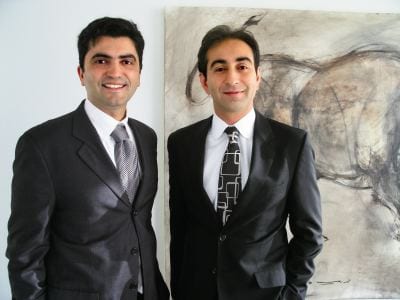
Azizzadeh (left) and Larian, in the lobby of their Beverly Hills, Calif, practice. PHOTOS BY JEFFREY FRENTZEN
Babak Azizzadeh, MD, FACS, is the director of the Center for Advanced Facial Plastic Surgery, located on busy Wilshire Blvd in Beverly Hills, Calif.
A native Angeleno, Azizzadeh earned bachelor’s and medical degrees at the David Geffen School of Medicine at UCLA, where he also received training in general surgery and otolaryngology—head and neck surgery.
At Harvard Medical School, he completed training in advanced facial plastic and reconstructive surgery, and in microvascular head and neck reconstruction. In addition, his research interests cover surgical treatments for facial nerve paralysis and Bell’s palsy.
Also from LA, Babak Larian, MD, received his medical degree from the University of California, Irvine School of Medicine, where he was recognized for academic and humanitarian distinction, followed by a residency in head and neck surgery at UCLA Medical Center.
Larian is the director of the Center for Advanced Head and Neck Surgery, which shares more similarities with Azizzadeh’s Center than just its name. They operate out of the same Wilshire Blvd location—a state-of-the-art, ultramodern facility that boasts Green technology—but the similarity does not end even there.
Though not related, the two Babaks are like soul brothers. They have known each other since their school days, after which they grew together as friends, colleagues, and eventually compatible business partners. And they are both raising young families, concurrently.
These surgeons have created a combined practice made of complementary specialties, and which focuses on collaborating with other specialists—what many practitioners deem to be an emerging trend in aesthetic medicine.
LIFE’S THREADS INTERTWINED

Larian reviews his daily schedule prior to the first appointment of the day.
Azizzadeh explains that he, a plastic surgeon, and Larian, an ENT surgeon, have an interesting partnership. Although they have their own independent practices, they also have a partnership in this practice. They also have partnerships in other business ventures, including pro-bono surgical missionary trips.
After doing their residencies together, Larian specialized in head and neck surgery, and Azizzadeh took on the field of facial reconstructive surgery.
Larian shifts in his seat, which is next to his partner’s, and contemplates how to best answer my question: What’s it like to partner with a plastic surgeon?
“You know, when I was in training,” he says, “one of the doctors that had become a plastic surgeon said they’d never want to try and combine the two together. You can’t have a practice. You can’t be good at both. But I disagree. You can be good at both. We both received training in ENT and plastics. Our boards involve ENT and plastics, and so they’re really very complementary. The reality to me is you can’t be good at one without being good at the other.”
Both men separately mention the high quality of their professional collaboration. “We have certain operations that we do together,” Azizzadeh says. “We often pick each other’s brains and we collaborate at an advanced, in-depth level. We’re like two peas in a pod. It’s a great connection and very gratifying. We think about each other before we think about ourselves. I mean, seriously, it’s really amazing.”
“It actually works out very well,” Larian adds. “Whenever you have two surgeons in the OR—two surgeons that are complementary—you’re getting two brains. I’ll be doing something, and he’ll say, ‘You know what I think? Maybe you should be trying this. You’ll do better.’ Invariably, it’s true. You get a different perspective in there, and it ultimately ends up being a much better solution for the patient. Even if I disagree with him, I know it’s worth the discussion because something good will come out of it. I always trust his judgment.”
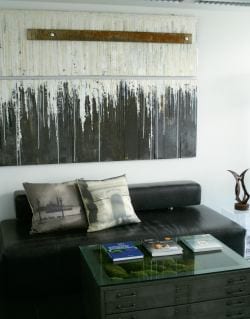
The new office location took 3 years to locate.
AESTHETIC BROTHERHOOD
He’s like my brother, Larian says of Azizzadeh. “He probably knows more things about me than anybody else in my life. I am very, very fortunate. Money’s never a concern between us. I worry about his practice more than he does, and he worries about my practice more than I do.”
Each partner carries around an understanding of what the other person does. “That makes it easy,” Larian continues. “When we first started, I was trying to do everything. I was trying to do plastics, but I could only do a good job at certain things like facial paralysis and reconstruction, while he is so amazing at what he does.” He adds that he is doing his patients a favor by handing them over to his partner, and vice versa.
“I can see the skill set of my partner,” he says. “Ultimately, if you were doing this to help people, you’re going to help them by giving them to the most qualified surgeon available. In my case, on many procedures it’s my medical partner. I believe that if there is someone who does things better than me, then I am going to refer to that person. And it goes back and forth.
“Dr Azizzadeh has patients who have sinus problems, nasal problems, and breathing issues. He wants me to take care of them because those procedures are more in line with my level of surgical expertise. When we have serious cases, we can do those cases together, He’ll do the aesthetic part of the nose, and I’ll do the functional aspects.”
FACIAL PARALYSIS EXPERT
Within the facial plastic surgeon community, Azizzadeh has stood out for his superior-quality rhinoplasty and facelifts. Beyond that, he has become a leader at treating facial paralysis and Bells Palsy, a role he says is very gratifying.
Partially, that reputation comes from having successfully developed procedures and treatments such as his cross-nerve facial grafting technique, as well as the number of successful cases he has performed.
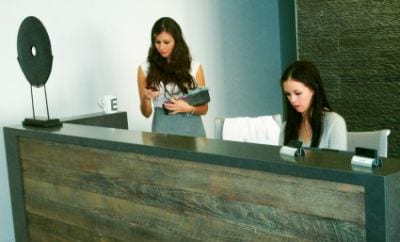
The surgeons’ new office on Wilshire Blvd is ultramodern and uses Green technology.
“Facial paralysis as an arena is fascinating to me,” Azizzadeh says. “It’s just a fascinating disease process, because there are so many different causes of facial paralysis. Historically, treatments have been mostly from the angle of reconstructive surgery, and not so much about quality of life.”
Azizzadeh states that when working with a facial paralysis patient his goal is to do more than just lift the corner of the mouth. He takes a more holistic approach to what the facial paralysis patients need.
“All of my treatment protocols incorporate the patient’s age, lifestyle, social situation, as well as the best surgical approach,” he says, “including nerve grafting, Botox, fillers if necessary for facial balance, and, in the case of an older patient, possibly a combined facelift.”
One of his most significant procedures involves the trigeminal nerve, which he uses to move the facial nerve. A recent case involved a young girl named Gracie, who had complete paralysis on the left side of her face, resulting in difficulty smiling and lack of facial tone.
In the first stage, he took a segment of nerve from her leg (sural nerve) and attached it to her normal facial nerve on the right side of her face. He calls this a “cross facial nerve graft.” In general, the nerve will become activated over a 6-month period.
In the second stage, he took a “live” muscle from Gracie’s thigh—the gracilis muscle, with its nerve, artery, and vein. This muscle was then transplanted to the paralyzed side of her face and attached to the nerve graft laid down in the first stage. Its artery and vein was also attached, so the muscle would remain viable. In the third stage, he refined the gracilis muscle bulk and attachment to the laugh line of Gracie’s face to create a more balanced smile.
Azizzadeh’s interest in facial paralysis came out of his days as a resident. “One of my wife’s best friends had a brain tumor,” he explains. “They took the tumor out, and she had facial paralysis. And no one paid attention to it.” She told him her doctors were so concerned about the tumor, they did not deal with the paralysis.
He saw a beautiful 30-year-old woman with a condition that was severely impacting her life and holding her back socially. “I’ve always done facial rejuvenation. I felt that with facial paralysis patients, I could really combine my surgical skills, academic mind, and love for humanity, and develop more advanced techniques to further improve the field.”
CHANGING OFFICES
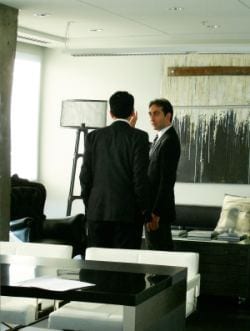
Azizzadeh (left) and Larian confer in the lobby.
This year, Azizzadeh and Larian moved 6 blocks up the boulevard to new office space. The move came from a common need among many practices, which eventually must relocate to expand or remain competitive. Their mission was to upgrade and offer a few things patients would not find elsewhere.
It took them 3 years to find the right space. “I saw so many spaces,” Azizzadeh says. “I was very, very picky because we’re going to be here for a long time. There are a lot of buildings around here, but I really loved this space. First of all, for patients you’re on Wilshire Boulevard. You have access from Canon on Beverly Drive. If your patients want privacy, they have privacy. Not like on Camden or Bedford. All the doctors’ offices are there. You see all the paparazzi hanging around there.”
They had a vision, Larian says. “We wanted to do something that would complement how we want to approach patients and how we want to do our work. Our offices are just a manifestation of that. We want to show people that we’re professional. We’re going to make it as pleasant an environment for you while you’re going through all these difficult times. You’re going to feel our support from us. You’re going to feel that we’re here to help you.”
The choice of office space, therefore, focused on patient comfort and safety, as well as being as eco-friendly as possible. A frequently asked question during the hunt for office space was, how would the patient be most comfortable?
“Most plastic surgeons and dermatologists have nice offices, but we wanted to focus on getting our patients very relaxed,” he says. “Quite often, patients are anxious when they go to a doctor’s office, especially when they’re thinking about doing aesthetic or reconstructive procedures. We really try to focus the office into a very relaxed mood, the kind of environment where the patients are put at ease.”
What has been the feedback from clients that knew both office locations? “They’re much more comfortable,” Azizzadeh says. Mission accomplished.
ANOTHER TYPE OF MISSION
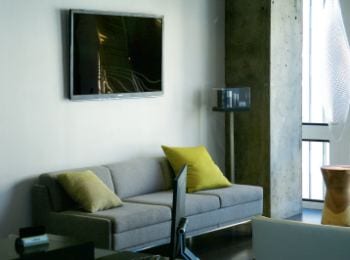
The new office was designed with patient comfort in mind.
Besides running a successful business, both physicians are involved in mission trips to provide free medical care to people in developing countries.
“I think that a lot of people do still go into medicine for the right reason,” Azizzadeh says. “These are people who are not just book smart in sciences but have bigger passions in life. Charitable work has always been a huge aspect of my life, and I enjoy it.”
Both men feel it is one’s duty to give back to society. “Everyone does it in a different way,” he continues. “There’s writing checks, which is great. Some people have a more hands-on involvement, and that’s where Dr Larian and I think alike.”
Larian explains that many practices have patients who come in without any financial resources whatsoever, but with problems that need surgical intervention. They both get involved if patients come in who don’t have a lot of means, and they do whatever they can to make that surgery happen for that patient.
In the case of facial paralysis patients, Azizzadeh started a foundation. In other cases, they do their best to work with insurance companies or raise funds through charity events.
Who got the idea to go on the mission trips?
“Both of us, independently,” Larian says. He was doing his fellowship in Boston, and joined a program that took him to Central America. The same year he started a practice in LA, a local nurse was leading a mission to Guatemala and asked him to go.
“I went on the Guatemala mission. I’m now the leader of it. Every year, I do all the planning for the trip. All year long, we’re collecting drugs, sutures, and materials. The mission is actually pretty incredible—80 to 90 people come. We go to a place that’s like an old hospital that’s not being used. We hook up the electricity and plumbing, and we put the whole thing together for a week. Whoever shows up, we take care of them.
“We usually see about a thousand patients and do about 150 surgeries in a week, close up shop, and leave,” he continues. “Guatemala has more medical conditions than any other country in the world. They’re so poor there.”
So, what’s next for this dynamic duo?
“Ensuring that we remain cutting edge in our surgical technique and expertise,” Azizzadeh says.
“And may we always be able to use that expertise to help our patients here in the US, as well as those less fortunate than us elsewhere,” Larian adds.
Sarah Russel is a contributing writer for PSP. She can be reached at [email protected].



